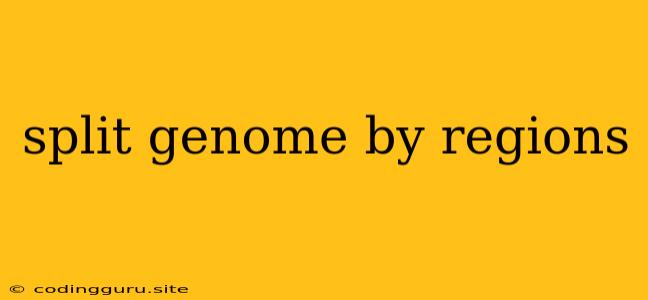Splitting a Genome by Regions: A Guide to Genome Partitioning
Genome analysis is a complex process, often involving massive datasets that can be computationally challenging to handle. Splitting a genome by regions can significantly simplify analysis and improve efficiency. This technique breaks down the vast genomic landscape into smaller, more manageable units, allowing for focused investigations.
Why Split a Genome?
There are several compelling reasons to split a genome by regions:
- Reduced computational complexity: Analyzing an entire genome can be resource-intensive, requiring significant processing power and memory. Dividing the genome into smaller regions allows for parallelization, enabling faster analysis.
- Focused analysis: Instead of analyzing the entire genome at once, you can target specific regions of interest, such as genes, chromosomes, or functional domains. This allows for deeper exploration of specific biological processes or mutations.
- Improved data management: By partitioning the genome, you can create manageable data files, making it easier to store, access, and share.
- Enhanced visualization: Analyzing smaller regions can lead to clearer and more informative visualizations, highlighting important patterns and anomalies.
How to Split a Genome by Regions
There are various approaches to splitting a genome by regions, each with its own strengths and weaknesses:
1. Chromosomal Partitioning:
The most straightforward approach is to split the genome based on chromosomes. This is a natural division, as each chromosome represents a distinct physical entity.
Example: In humans, the genome can be divided into 23 chromosomes. Each chromosome can be analyzed individually, offering insights into specific genetic traits.
2. Gene-Based Partitioning:
This method focuses on dividing the genome into regions defined by genes. This is useful for studying gene expression, regulation, and mutation effects within specific gene loci.
3. Functional Domain Partitioning:
This approach categorizes the genome based on functional domains, such as coding regions, non-coding regions, regulatory elements, and repetitive sequences. This allows for targeted analysis of specific functional aspects of the genome.
4. Custom Region Definition:
For more specific analysis, you can define custom regions based on your research goals. For instance, you could define regions based on specific gene clusters, conserved regions, or regions known to be associated with certain diseases.
Tools for Splitting Genomes:
Several software tools facilitate genome partitioning:
- BEDTools: This suite of tools offers efficient commands for manipulating and analyzing genomic data, including splitting by regions.
- samtools: This toolkit provides utilities for manipulating and analyzing sequence alignment data, allowing for region-based analysis.
- GATK: This widely used tool for variant calling and genome analysis includes functionalities for splitting genomes into regions.
- Biopython: This Python library provides comprehensive functionalities for working with biological data, including tools for splitting genomes.
Considerations for Splitting Genomes:
- Overlap between regions: Ensure that regions are properly defined to avoid overlapping data that can lead to errors or inconsistencies.
- File formats: Choose suitable file formats (e.g., BED, VCF, FASTA) for storing and manipulating split genome data.
- Data integrity: Maintain the integrity of the original data during splitting, avoiding any loss of information.
- Analysis workflow: Ensure that the splitting method aligns with your downstream analysis workflow.
Conclusion
Splitting a genome by regions is a powerful technique for streamlining and enhancing genome analysis. By partitioning the genome into manageable units, researchers can focus on specific areas of interest, improve computational efficiency, and gain deeper insights into complex biological processes. Choosing the right method and utilizing appropriate tools are key to achieving effective genome partitioning and maximizing research outcomes.
